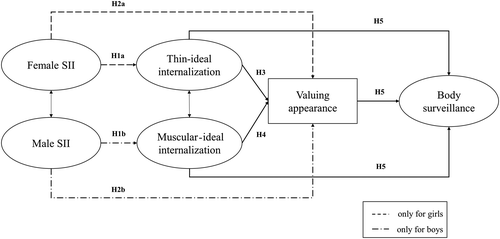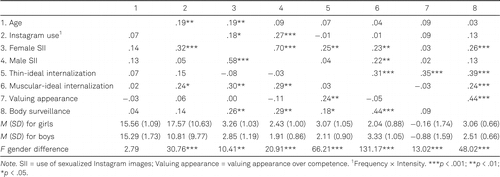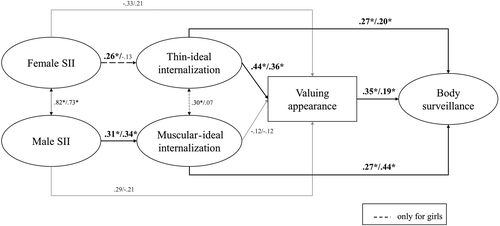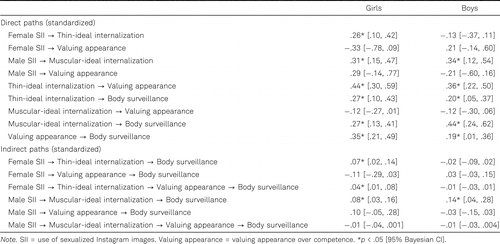Links Between Exposure to Sexualized Instagram Images and Body Image Concerns in Girls and Boys
Abstract
Abstract. The current study examined the links between viewing female and male sexualized Instagram images (SII) and body image concerns within the three-step process of self-objectification among adolescents aged 13–18 years from Germany (N = 300, 61% female). Participants completed measures of SII use, thin- and muscular-ideal internalization, valuing appearance over competence, and body surveillance. Structural equation modeling revealed that SII use was associated with body image concerns for boys and girls via different routes. Specifically, female SII use was indirectly associated with higher body surveillance via thin-ideal internalization and subsequent valuing appearance over competence for girls. For both girls and boys, male SII use was indirectly linked to higher body surveillance via muscular-ideal internalization. Implications for the three-step model of self-objectification by sexualized social media are discussed.
Instagram is one of the fastest-growing social networks and is most popular among teenagers, of whom 72% are using it (Pew Research Center, 2018). With over 100 million photographs uploaded on Instagram per day (Instagram, 2019), adolescents are likely to be exposed to a high number of images on a regular basis. There is a large body of research linking sexualized media, defined as media emphasizing sexual appearance and sexual appeal to others, to body image concerns (Karsay et al., 2018; Ward, 2016). Yet scholars have called for more research focusing on social media specifically and including male samples (Ward, 2016). The purpose of this study is to examine associations between adolescents’ use of sexualized Instagram images (SII) and body image concerns, conceptualized here as appearance-ideal internalization (thin- and muscular-ideal), valuing appearance over competence, and body surveillance. The study extends previous research by examining the specific association of exposure to both male and female SII, by examining the role of different forms of appearance-ideal internalization (thin- and muscular-ideal), and by including both male and female adolescents.
Sexualized Media Use and Self-Objectification
A well-supported theoretical framework for understanding the relation of media exposure with body image is objectification theory (Fredrickson & Roberts, 1997). The theory states that women in Western culture learn from an early age that their body is evaluated by others and gradually internalize this observer perspective, thereby learning to evaluate themselves from a third-person, appearance-focused point of view. This process is called self-objectification and has been linked to numerous negative outcomes for women (Tiggemann & Williams, 2011). Self-objectification is manifested at the cognitive level in individuals’ tendency to value appearance over competence (further referred to as valuing appearance); at the behavioral level, it is shown through persistent body surveillance (Calogero, 2011). Following objectification theory, sexualized media constitute one form of objectification and contribute to the development of self-objectification (Fredrickson & Roberts, 1997). Accordingly, an extensive body of correlational research has demonstrated links between the use of sexualized media and self-objectification, and experimental research demonstrated that women exposed to sexualized media in the laboratory show heightened self-objectification (Karsay et al., 2018; Ward, 2016).
Media researchers have further identified women’s tendency to internalize the society’s appearance ideal as a mediator in this relation. A prominent model featuring appearance-ideal internalization is the three-step model of self-objectification by Vandenbosch and Eggermont (2015). The authors postulate that sexualized media predict valuing appearance directly and indirectly via appearance-ideal internalization. Both of these facets then increase body surveillance. This model has been tested with adolescents’ traditional media use and general Facebook use (Vandenbosch & Eggermont, 2012, 2015).
Self-Objectification and Gender
Objectification theory was originally developed to describe the experiences of women. Yet, sexualized portrayals of men in the media have increased in past decades, resulting in more pressure for boys to be muscular and look sexy (Vandenbosch & Eggermont, 2013). Research is needed to clarify whether the relations between sexualized media and self-objectification are similar among boys and girls (Moradi, 2010). So far, studies have found that female and male adolescents’ use of sexualized traditional media (Vandenbosch & Eggermont, 2012, 2015), and SII use (Skowronski et al., 2020) predict self-objectification via appearance-ideal internalization, with no evidence of a moderating effect of gender. However, these studies did not take the gender of the sexualized media subjects into account, which may also be relevant for the relation between media use and self-objectification. The essential proposition of objectification theory is that women internalize an outside-perspective on themselves because they experience objectification through the sexualization of women (Fredrickson & Roberts, 1997). In the same fashion, men should internalize this perspective through experiences of male sexualization. On Instagram, sexualized women primarily convey the standard of thinness, and research has demonstrated that thin-ideal internalization is an essential variable for girls (Thompson & Stice, 2001). By contrast, male sexualization typically focuses on muscularity and strength (Carrotte et al., 2017). Accordingly, previous studies have shown that exposure to thin-ideal images increases body image concerns in girls, but not in boys (Hargreaves & Tiggemann, 2004). Male body image concerns are more closely linked to the muscular ideal (Thompson & Cafri, 2007). It may thus be reasoned that female images are associated with thin-ideal internalization for girls, and male images are linked to muscular-ideal internalization for boys (Moradi, 2010).
Sexualization on Instagram
Studies that specifically measure the habitual consumption of sexualized images on Instagram are rare. At the same time, Instagram is a purely picture-based platform, and users may encounter images of both peers and celebrities simultaneously on the platform, possibly rendering sexualized images more relevant to their body image concerns (Holland & Tiggemann, 2016). Most importantly, Instagram is known for the wide-spread use of appearance-based hashtags (Tiggemann & Zaccardo, 2018) and its particularly large amount of male sexualized images (Carrotte et al., 2017). Because Instagram is especially popular among teenagers (Medienpädagogischer Forschungsverbund Südwest, 2019), research is needed on links between male and female images on Instagram and adolescents’ body image concerns. Examining the differential use of, and pathways from, sexualized male and female images, Instagram is a relevant object of study because it addresses both thinness and muscularity, as reflected in popular hashtags like #thinspiration and #fitspiration (Carrotte et al., 2017; Ghaznavi & Taylor, 2015). Previous studies examining social media either focused on general measures of internalization without differentiating between thinness and muscularity (Vandenbosch & Eggermont, 2015) or did not differentiate between the gender of the sexualized persons (Skowronski et al., 2020). Thus, the proposition that SII of males and females may be differentially associated with thin-ideal and muscular-ideal internalization for girls and boys has not yet been tested.
The Current Study
To address these limitations, the current research measured boys’ and girls’ use of male and female SII and tested associations in an extended model derived from the three-step self-objectification process (Vandenbosch & Eggermont, 2015). The prediction model is presented in Figure 1. Extending previous research, we predicted gender differences in the relations between male and female SII and facets of internalization. Specifically, we assumed that for girls, female SII would be linked to thin-ideal internalization (Hypothesis 1a) and valuing appearance (Hypothesis 2a), whereas, for boys, male SII would be linked to muscular-ideal internalization (Hypothesis 1b) and valuing appearance (Hypothesis 2b). For both genders, we assumed that valuing appearance would be predicted by thin-ideal internalization (Hypothesis 3) and muscular-ideal internalization (Hypothesis 4). We further assumed that higher thin-ideal, muscular-ideal internalization, and valuing appearance would predict greater body surveillance (Hypothesis 5). Finally, we hypothesized that higher use of gender-congruent SII (female SII for girls, male SII for boys) would be indirectly linked to greater body surveillance via thin-ideal internalization and valuing appearance for girls and via muscular-ideal internalization and valuing appearance for boys (Hypothesis 6).

Method
Participants
Participants were recruited by spreading the link to the online survey via secondary school teachers, youth club leaders, and Instagram. Of the 379 adolescents who started filling in the survey, 313 reached the end of the survey (dropout rate of 17.41%). Thirteen participants were excluded (9 did not specify their gender, 4 did not answer the Instagram questions), resulting in a final sample of N = 300 (183 female, 117 male) with a mean age of M = 15.46 years (SD = 1.38). Participants could opt to take part in a raffle of Amazon vouchers worth 10€.
Instruments
Use of Sexualized Instagram Images (SII Use)
Participants were shown three pictures of sexualized women and three pictures of sexualized men taken from public Instagram profiles. The pictures showed young adults in various forms of scarce clothing and body-emphasizing poses. Pictures were validated in a pilot study (described in the Electronic Supplementary Material, ESM 1) and are available upon request. For each picture, participants were asked to rate how often they see similar pictures on Instagram on a 5-point scale from 1 (= never) to 5 (= very often). Participants were told that they should not focus on the specific persons but on the way in which they were presented (e.g., clothing, pose). Cronbach’s αs were .85 for the female SII scale and .83 for the male version.
Appearance-Ideal Internalization
The Thin/Low Body Fat and the Muscular/Athletic subscales of the Sociocultural Attitudes Towards Appearance Questionnaire – 4 Revised (SATAQ-4R) were used (Schaefer et al., 2017). Participants rated the extent to which they strive toward appearance ideals on a scale from 1 (= strongly disagree) to 5 (= strongly agree). The Thin subscale consisted of three items (e.g., “I want my body to be very thin”), α = .84, the Muscular subscale of four items (e.g., “It is important for me to look muscular”), α = .93.
Valuing Appearance
Valuing appearance was assessed by an adapted version of the Self-Objectification Questionnaire (Noll & Fredrickson, 1998; Vandenbosch & Eggermont, 2012). Participants were asked to rate the importance of 10 body attributes (e.g., weight, physical fitness) from 1 (= not at all important) to 10 (= very important). The difference between participants’ mean scores on the appearance-based scale (α = .79) and the competence-based scale (α = .83) determined participant’s score of valuing appearance. A factor analysis confirmed the two-factorial structure (see ESM 2).
Body Surveillance
An adapted version for German adolescents of the Surveillance subscale of the Objectified Body Consciousness Scale was used (Knauss et al., 2008; McKinley & Hyde, 1996). The scale consisted of 11 items (e.g., “During the day, I think about how I look many times”), rated on a scale from 1 (= strongly disagree) to 4 (= strongly agree), α = .84. Following the procedure of previous research (Sevic et al., 2020; Vandenbosch & Eggermont, 2015), four items of the body surveillance subscale were used to create the latent variable.1
Control Variable
To control for participants’ overall Instagram use, participants indicated on a scale from 1 (= not at all) to 7 (= more than 20 times) how often they check Instagram on an average day. They further reported how much time they spend on Instagram on a typical day on a scale from 1 (= no time at all) to 7 (= 4 hours or more). The product of frequency and intensity was calculated to yield a score of overall Instagram use.
Procedure
The study was conducted online using the Limesurvey software. After providing informed consent, participants completed the body image measures followed by the Instagram questionnaires, before they were debriefed online. The study was approved by the Ethics Committee of the authors’ university.
Overview of Bayesian Analysis
To test our hypotheses, we used the modern Bayesian methodology, which has gained popularity in psychological research (van de Schoot et al., 2017). This approach enabled us to translate our theoretical expectations into prior distributions, which were then incorporated into the analysis to test the probability of the hypothesized model, given the data (Muthén & Asparouhov, 2012). Furthermore, the Bayesian approach offers several advantages over frequentist approaches for evaluating our proposed model: First, it does not rely on large sample sizes. Second, population parameters (e.g., means or regression coefficients) are described by probability distributions, which reflect beliefs about the uncertainty about the population parameters rather than assuming one unknown, but fixed true value, like in frequentist approaches. Third, when examining complex models as in this study, frequentist approaches often pose overly strict assumptions because they assume exact zero cross-loadings and exact invariance between constructs. By contrast, Bayesian methodology allows for some “wiggle room” by applying prior distributions centered around zero to different parameters and cross-loadings (Winter & Depaoli, 2020).
Results
Descriptive Statistics and Correlations
Differences between boys and girls were tested with SPSS 26 using one-way analyses of variance instead of multivariate analysis of variance, which uses listwise deletion. An α-level of p < .006 (.05/8) was used to correct for multiple comparisons. Table 1 displays the descriptive statistics and zero-order correlations for all study variables. Gender differences were found on all variables, with girls scoring higher on all variables except for muscular-ideal internalization, on which boys had higher scores. Male and female SII use significantly correlated with each other and with muscular-ideal internalization for boys and girls. For girls, female SII use correlated with thin-ideal internalization. Female SII use (for boys and girls) and male SII use (for boys) were correlated with body surveillance. SII use and valuing appearance were uncorrelated.

Hypothesis Testing
To examine the proposed paths and gender differences in the associations, the structural equation model presented in Figure 1 was tested using latent class analyses with Mplus 8.5. For female SII, male SII, thin- and muscular-ideal internalization, and body surveillance, the respective items were used as indicators of the latent variables. Due to its rank-order format, we included valuing appearance as a manifest variable in the model. All variables were controlled for general Instagram use and age. Relying on our assumptions, we applied normally distributed zero-mean small variance prior distributions (variance of 0.01) to the differences between factor loadings and item intercepts for boys and girls and to the differences between the paths supposed to be equal for boys and girls, reflecting the assumption that the findings would not vary by gender. The priors of the loadings of the items for SII and internalization on the non-expected latent factor were set to a normally distributed zero mean with small variance (0.01). Uninformative Mplus default priors were applied to all other model parameters. No differences between boys and girls in the factor loadings and item intercepts were significant, indicating approximate strong measurement invariance across gender groups. The model showed a good fit, PPP < .001, CFI = .95, RMSEA = .05. The standardized coefficients are presented in Figure 2. To test the significance of both direct and indirect paths, 95% Bayesian credibility intervals were calculated which are presented in Table 2.


Hypothesis 1a that female SII would be associated with heightened thin-ideal internalization for girls, but not for boys was confirmed. Furthermore, male SII was linked to muscular-ideal internalization for boys, consistent with Hypothesis 1b. Against our prediction, male SII also predicted muscular-ideal internalization in girls. The proposed positive paths to valuing appearance from female SII for girls and from male SII for boys were not significant, failing to support Hypotheses 2a and 2b. As predicted in Hypothesis 3, thin-ideal internalization predicted valuing appearance for girls and boys. However, muscular-ideal internalization did not predict valuing appearance, lending to no support to Hypothesis 4. We further found that thin- and muscular-ideal internalization and valuing appearance predicted body surveillance for boys and girls, consistent with Hypothesis 5. In Hypothesis 6, we proposed indirect links from gender-congruent SII (female for girls, male for boys) to body surveillance via internalization (thin-ideal for girls, muscular-ideal for boys) and valuing appearance. This prediction was supported for girls only. For boys, we found indirect links from male SII to body surveillance only via internalization. We also found evidence that male SII was indirectly linked to body surveillance via muscular-ideal internalization for girls.
Discussion
The current study used objectification theory (Fredrickson & Roberts, 1997) to examine the role of exposure to gendered sexualized images in adolescents’ habitual Instagram use for understanding self-objectification. Expanding previous models (Vandenbosch & Eggermont, 2015), we investigated both muscular-ideal and thin-ideal internalization in this relation. Consistent with our hypotheses, female SII use was associated with body surveillance indirectly via thin-ideal internalization and valuing appearance for girls. Furthermore, male SII use was indirectly linked to body surveillance via muscular-ideal internalization for both gender groups. While female images are associated with the thin-ideal for girls, male sexualization highlights the muscular body ideal for both boys and girls. This result might mirror the current shift in female appearance ideals in the context of Instagram: Having a muscular body has become an important trend among girls, and male pictures are presented at a substantial rate in this context (Tiggemann & Zaccardo, 2018). This makes it more likely for girls to internalize the muscular ideal when seeing male sexualized images, which usually emphasize muscularity (Vandenbosch & Eggermont, 2013).
On the whole, our results suggest that sexualization on Instagram might contribute to adolescents’ body image concerns, similar to sexualized content in traditional media (Karsay et al., 2018). However, as a social medium, Instagram may have implications for the further development of objectification theory: Users typically follow similar accounts along with their peers, which renders using Instagram a socially shared experience. For instance, users often discuss the bodies of the individuals they see on Instagram, which might intensify the links between sexualized images and self-objectification (Wang et al., 2020). Future research is needed to examine these assumptions. It would further be interesting to test whether body-positive content on Instagram might buffer this proposed effect, as it might lead individuals to question body ideals.
Against our predictions, we did not find direct paths from female and male SII use to valuing appearance. Moreover, we did not find a significant path from muscular-ideal internalization to valuing appearance. A reason may be that valuing appearance reflects the tendency to value appearance attributes like weight and shape, associated with the thin ideal, over competency attributes like fitness and strength, associated with muscularity. If people score high on muscular-ideal internalization, they might not value appearance over competence, or even value the competence attributes over appearance. Overall, our study underlines the need for more research on the concepts of thin- and muscular-ideal internalization and their relevance for valuing appearance.
Limitations
The current study is limited by its correlational design. As such, it cannot support statements about the causal order of the model variables. However, longitudinal and experimental studies confirm the temporal order assumed in our study (Ward, 2016). Therefore, our results are consistent with the proposition that habitual SII use may negatively affect male and female adolescents’ body image. Following Slater’s (2007) theory on reinforcing spirals, adolescents with a negative body image might specifically select media high in sexualization. Longitudinal designs are needed to test this possibility. Indeed, recent longitudinal research found evidence for reverse relationships between appearance-ideal internalization and body surveillance (Vangeel et al., 2018). Future research should further control for user variables like body mass index (BMI), which was not assessed in this study. However, some research speaks against the role of BMI as a covariate in the association between sexualized media use and self-objectification (Skowronski et al., 2020).
In sum, our findings provide support for objectification theory (Fredrickson & Roberts, 1997) and the three-step process of self-objectification (Vandenbosch & Eggermont, 2015). They also have theoretical implications for the growing literature on male sexualization and self-objectification. The findings highlight the central and gendered role of appearance-ideal internalization, with muscular-ideal internalization being relevant for boys and both thin- and muscular-ideal internalization being relevant for girls. Therefore, muscular-ideal internalization should be included in future research. Together, the findings show that SII use is linked to body image concerns for both boys and girls, but the relevant stimuli might differ between genders: Female and male sexualized images relate to body image concerns for girls, whereas for boys, male images appear to be more relevant. As male sexualization in the media increases, this is an important finding for intervention programs that should target boys and girls alike and take gendered preferences for sexualized media content into account.
Electronic Supplementary Materials
The electronic supplementary material is available with the online version of the article at https://doi.org/10.1027/1864-1105/a000296
Marika Skowronski is currently enrolled as a doctoral student in Social Psychology at the University of Potsdam, Germany. Her research examines sexualization in the media and its relation to body image concerns.

Robert Busching is a Post-Doctoral Researcher at the University of Potsdam, Germany. His main research areas are social risk factors for aggressive behavior as well as group influences. Additionally, he is interested in the statistical modeling of behavior.

Barbara Krahé is Professor of Social Psychology at the University of Potsdam, Germany. Her research focuses on media violence, gender stereotypes, and sexual aggression. She is the recipient of the German Psychology Prize 2015 for her work on aggression.

1We tested the same model with all items of the body surveillance scale. The results remained unchanged except for a slight decrease in model fit.
References
(2011).
Operationalizing self-objectification: Assessment and related methodological issues . In R. M. CalogeroS. Tantleff-DunnJ. K. ThompsonEds., Self-objectification in women: Causes, consequences, and counteractions (pp. 23–49). American Psychological Association. https://doi.org/10.1037/12304-002(2017). “Fitspiration” on social media: A content analysis of gendered images. Journal of Medical Internet Research, 19(3), Artilce e95. https://doi.org/10.2196/jmir.6368
(1997). Objectification theory: Toward understanding women’s lived experiences and mental health risks. Psychology of Women Quarterly, 21(2), 173–206. https://doi.org/10.1111/j.1471-6402.1997.tb00108.x
(2015). Bones, body parts, and sex appeal: An analysis of #thinspiration images on popular social media. Body Image, 14, 54–61. https://doi.org/10.1016/j.bodyim.2015.03.006
(2004). Idealized media images and adolescent body image: “Comparing” boys and girls. Body Image, 1(4), 351–361. https://doi.org/10.1016/j.bodyim.2004.10.002
(2016). A systematic review of the impact of the use of social networking sites on body image and disordered eating outcomes. Body Image, 17, 100–110. https://doi.org/10.1016/j.bodyim.2016.02.008
. (2019). Instagram statistics. https://instagram-press.com/our-story/
(2018). Sexualizing media use and self-objectification: A meta-analysis. Psychology of Women Quarterly, 42(1), 9–28. https://doi.org/10.1177/0361684317743019
(2008). Body dissatisfaction in adolescent boys and girls: Objectified body consciousness, internalization of the media body ideal and perceived pressure from media. Sex Roles, 59(9–10), 633–643. https://doi.org/10.1007/s11199-008-9474-7
(1996). The objectified body consciousness scale: Development and validation. Psychology of Women Quarterly, 20(2), 181–215. https://doi.org/10.1111/j.1471-6402.1996.tb00467.x
. (2019). JIM-Studie 2019: Jugend, Information, Medien
[JIM study 2019: Youth, information, media] . https://www.mpfs.de/studien/jim-studie/2019/(2010). Addressing gender and cultural diversity in body image: Objectification theory as a framework for integrating theories and grounding research. Sex Roles, 63(1–2), 138–148. https://doi.org/10.1007/s11199-010-9824-0
(2012). Bayesian structural equation modeling: A more flexible representation of substantive theory. Psychological Methods, 17(3), 313–335. https://doi.org/10.1037/a0026802
(1998). A mediational model linking self-objectification, body shame, and disordered eating. Psychology of Women Quarterly, 22(4), 623–636. https://doi.org/10.1111/j.1471-6402.1998.tb00181.x
. (2018). Teens, social media & technology 2018. http://www.pewinternet.org/wp-content/uploads/sites/9/2018/05/PI_2018.05.31_TeensTech_FINAL.pdf
(2017). Development and validation of the Sociocultural Attitudes Towards Appearance Questionnaire – 4-Revised (SATAQ-4R). The International Journal of Eating Disorders, 50(2), 104–117. https://doi.org/10.1002/eat.22590
(2020). The relationship between the use of social networking sites and sexually explicit material, the internalization of appearance ideals and body self-surveillance: Results from a longitudinal study of male adolescents. Journal of Youth and Adolescence, 49(2), 383–398. https://doi.org/10.1007/s10964-019-01172-2
(2020). Predicting adolescents’ self-objectification from sexualized video game and Instagram use: A longitudinal study. Sex Roles. Advance online publication. https://doi.org/10.1007/s11199-020-01187-1
(2007). Reinforcing spirals: The mutual influence of media selectivity and media effects and their impact on individual behavior and social identity. Communication Theory, 17(3), 281–303. https://doi.org/10.1111/j.1468-2885.2007.00296.x
(2007). The muscular ideal: Psychological, social, and medical perspectives. American Psychological Association. https://doi.org/10.1037/11581-000
(2001). Thin-ideal internalization: Mounting evidence for a new risk factor for body-image disturbance and eating pathology. Current Directions in Psychological Science, 10(5), 181–183. https://doi.org/10.1111/1467-8721.00144
(2011). The role of self-objectification in disordered eating, depressed mood, and sexual functioning among women. Psychology of Women Quarterly, 36(1), 66–75. https://doi.org/10.1177/0361684311420250
(2018). “Strong is the new skinny”: A content analysis of #fitspiration images on Instagram. Journal of Health Psychology, 23(8), 1003–1011. https://doi.org/10.1177/1359105316639436
(2017). A systematic review of Bayesian articles in psychology: The last 25 years. Psychological Methods, 22(2), 217–239. https://doi.org/10.1037/met0000100
(2012). Understanding sexual objectification: A comprehensive approach toward media exposure and girls’ internalization of beauty ideals, self-objectification, and body surveillance. Journal of Communication, 62(5), 869–887. https://doi.org/10.1111/j.1460-2466.2012.01667.x
(2013). Sexualization of adolescent boys. Men and Masculinities, 16(3), 283–306. https://doi.org/10.1177/1097184X13477866
(2015). The role of mass media in adolescents’ sexual behaviors: Exploring the explanatory value of the three-step self-objectification process. Archives of Sexual Behavior, 44(3), 729–742. https://doi.org/10.1007/s10508-014-0292-4
(2018). The multidimensional self-objectification process from adolescence to emerging adulthood. Body Image, 26, 60–69. https://doi.org/10.1016/j.bodyim.2018.05.005
(2020). Body talk on social networking sites, body surveillance, and body shame among young adults: The roles of self-compassion and gender. Sex Roles, 82(11–12), 731–742. https://doi.org/10.1007/s11199-019-01084-2
(2016). Media and sexualization: State of empirical research, 1995–2015. Journal of Sex Research, 53(4–5), 560–577. https://doi.org/10.1080/00224499.2016.1142496
(2020). An illustration of Bayesian approximate measurement invariance with longitudinal data and a small sample size. International Journal of Behavioral Development, 44(4), 371–382. https://doi.org/10.1177/0165025419880610



